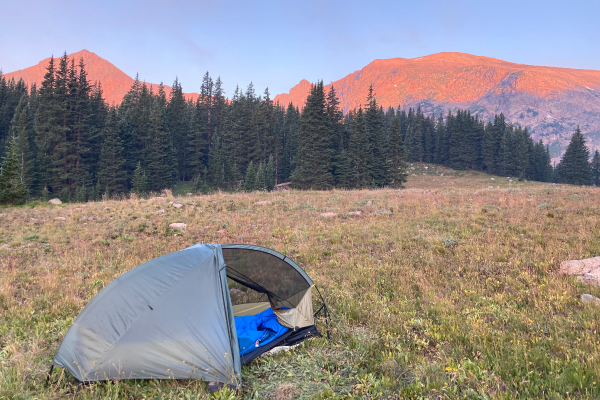"Meteor showers are like fishing. You go, you enjoy nature...and sometimes you catch something.” - Bruce McClure, EarthSky.org
 The author’s mobile observatory at 11,000’ in the Eagle’s Nest Wilderness. August 2020.
The author’s mobile observatory at 11,000’ in the Eagle’s Nest Wilderness. August 2020.
Fishing and chasing meteor sightings -- two of my backcountry passions -- have a number of things in common: Sometimes you lose count; other times you get skunked. Sometimes catching one or two feels like a big victory. Sometimes they are right there in front of you, but you can’t see them. Meteor showers are like schools of fish -- when you find one, you are likely to find others!
We experience meteor showers as the earth passes through particles emitted from comets, most commonly, and sometimes asteroids traveling through space. These space clouds are called meteor streams and, because they don’t move much, we pass through them about the same time every year as our spaceship orbits the sun. Each shower is named for the stellar constellation from which it appears to emanate, providing an easy way to locate the best place to look for them, though they often will appear all over the sky. There are about a dozen major, named showers a year.
The Perseids in August and the Geminids in December are two of the most accessible showers. In August 2021, I pitched my tent in an open basin at 10,500 feet in the Eagle’s Nest Wilderness and saw 30 Perseid fallers in 30 minutes. A rate of 60 per hour is very high. In December 2020, my wife and daughter and I drove up one evening to an open area in the national forest at about 7800 feet to view the Geminids. I brought chairs, quilts, banana-nut cookies, and made hot chocolate on my camp stove. We lost count of how many Geminids we saw in 40 minutes. It was spectacular.

Colorado Geminid Meteor Shower Stars Sky.
This year, the Geminid watching is likely to be fair to good. Earthsky.org reports that the Geminids will compete with a waxing gibbous moon (meaning a half moon that is building to full). That’s the bad news. But the moon will set enough before dawn that it will provide some dark hours, and some of the Geminids may be strong enough to overcome the moonlight. The authors recommend looking up between mid-evenings on December 13 until dawn of December 14. 
The source of the Geminids is unusual, because it is not a comet, made of ice, but an asteroid -- a big rock. Scientists are still puzzled why this asteroid not only sheds bits, creating a meteor shower, but also begins to glow as it approaches the sun. The leading theory is that asteroid 3200 Phaethon, contains a great deal of sodium that causes it to “fizz” and activate like a big ball of salt, as I imagine it.
I have found the NOAA weather site, which has hour-by-hour cloud-cover forecasts, to be helpful in avoiding futile nights in the cold. I also like the Night Sky app on my phone to help locate constellations and other sky features. It will even show you right where to look for the best view of meteor showers.
Here are some final tips for fishing for meteors:
1. Get to a dark, open sky. Clouds and a bright moon or other lights scare them away. Trust me, it’s worth the effort to get to a dark sky.
2. Bring a buddy. It’s more fun, and four eyes are better than two.
3. Make it fun and comfortable. Bring clothing and gear to stay warm, a comfortable chair or pad and sleeping bag, and food and beverage as appropriate.
4. Try to give yourself an hour or so of observing time. Your eyes can take up to 20 minutes to fully adjust, and the meteors can come in waves you don’t want to miss.
5. Don’t bother with binoculars or any special equipment. Your eyes are all you need!
Resources
https://www.backpacker.com/skills/the-experience-in-the-deep-dark-stargazing/
https://www.eaglesummitwilderness.org/
https://earthsky.org/astronomy-essentials/earthskys-meteor-shower-guide/
https://www.nps.gov/subjects/nightskies/stargaze.htm
Steve Elder is a board member of Eagle Summit Wilderness Alliance, which stewards and advocates for three Wilderness Areas here in the heart of Colorado: Holy Cross, Eagle’s Nest, and Ptarmigan.








